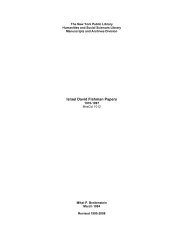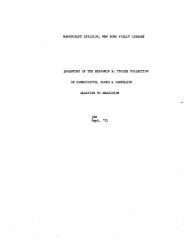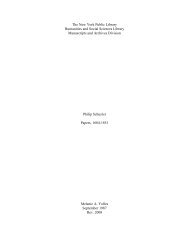pdf available - Multiple Choices
pdf available - Multiple Choices
pdf available - Multiple Choices
You also want an ePaper? Increase the reach of your titles
YUMPU automatically turns print PDFs into web optimized ePapers that Google loves.
194 LUBOML<br />
by peasants to weave cloth and make their own<br />
clothing.<br />
The machine stood in the lower room. A<br />
horse was harnessed to a shaft in a stable next<br />
door. It moved around in a circle, rotating the<br />
machine. That is how the factory operated.<br />
Next to the house a big place was reserved for<br />
the peasants' wagons. Right after the High Holy<br />
Days, this area was filled with wagons and with<br />
horses freed from their harnesses. The front room<br />
had big tables and long benches. The peasants<br />
and their wives would be seated around these<br />
tables, waiting their turn while making a meal out<br />
of slabs of black bread with lard and washing<br />
them down with vodka.<br />
Some of the peasants would cross the street<br />
to drop in on Chayke and drink tea. Chayke the<br />
tshaynitshke [tea lady] would ladle out hot water<br />
from a kettle and "put out the flame" in the<br />
stomachs of the peasants, caused by eating bread<br />
and lard.<br />
The hubbub of peasants and machines lasted<br />
from Sunday to Friday. Friday afternoon Avrom<br />
Etyes' house took on a different face. The floor<br />
was covered with yellow sand. The tables were<br />
scrubbed and covered with snow-white tablecloths.<br />
Candles were lit and the kerosene-lamps<br />
burned brightly through their clean washed glass<br />
chimneys.<br />
Here, Binyomen held his Sabbath minyan,<br />
where most of the surrounding neighbors came<br />
to daven [pray] on the Sabbath: Sholem and<br />
Yankef Cohen with their sons, Abba Klig, Avrom<br />
Shmilyukes, Shimshen-Zalmen Yankef's,<br />
Moyshe-Notl Gortenshteyn, the Kirnesees , Pinye-<br />
Hersh, Chaye Dobes, etc.<br />
Elye Horodler<br />
My uncle was called Elye Horodler, because<br />
his wife Paye was originally from the shtetl<br />
Horodle, near the Bug River. He knew no other<br />
kind of life than the one in which, being through<br />
with slaving in his bakery, he would go to the<br />
Stepenyer shtibl to pray and to study the sacred<br />
books. No weather ever prevented his going there.<br />
He was a quiet man, never making a racket, never<br />
taking part in social activities.<br />
My Aunt Paye always found time for two<br />
things: to help the poor for the Sabbath and to<br />
entertain company.<br />
Later on their son Yankl Lerner introduced a<br />
new way of making a living. He built himself a<br />
house on the land occupied by the garden. There<br />
he built a tanning plant. Huge tanks were buried<br />
in the earth, with rims slightly above the ground.<br />
Hides were soaked in these tanks in a liquid of<br />
lime and oak-bark, and workers would stir the<br />
hides with long steel tongs. The thick skins were<br />
dyed brown, to be later formed into soles for<br />
shoes. The thinner calf skins were dyed black.<br />
The thicker hides were called yuchtn and were<br />
used to make boots. The still thinner pieces were<br />
used for odds and ends.<br />
Merchants came from Lublin, Chelm and<br />
and other cities to buy the leather. Yankl and his<br />
brother Dovid (z"1) would take their wares by<br />
horse and wagon to Hrubyeshov and Ludmir.<br />
The trade would have brought in a fine income,<br />
but the Polish regime saw to it that little was left,<br />
barely enough to keep mouths filled. The rest was<br />
taken by them in taxes.<br />
Yankef-Leyzer Chesner<br />
Early before dawn Jews ran to pray in the first<br />
minyan. One of the earliest to arrive was Yankef-<br />
Leyzer, a haberdasher.<br />
Like all pious Jews, Yankef-Leyzer first of all<br />
ran to render unto God his morning prayer and<br />
then he would sit down to study a page of Gemara<br />
(commentaries on the Mishnah).<br />
All his life Yankef-Leyzer wore a long coat<br />
like the other Chasidim. It is taken for granted<br />
that he had a long beard and peyes (sidelocks1,<br />
but his were somehow different from those of the<br />
other Libivner Jews.<br />
His beard began together with the peyes so<br />
there was no distinct borderline between the<br />
beard and the peyes, only a forehead and a pair of<br />
eyes that peeped out from the forest of hair.<br />
Sedate as he was while at prayer, in his store<br />
Yankef-Leyzer was equally as distraught, for his<br />
mind was always on his studies. He was more<br />
immersed in the passage of the Gemara he had<br />
read that day than in any item in his store. This is<br />
why he ran around in the store as if in a daze when<br />
a customer came in to buy something His oldest







